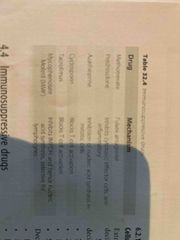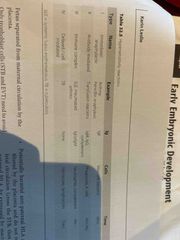![]()
![]()
![]()
Use LEFT and RIGHT arrow keys to navigate between flashcards;
Use UP and DOWN arrow keys to flip the card;
H to show hint;
A reads text to speech;
26 Cards in this Set
- Front
- Back
|
Phagocytes are made in |
Bone marrow |
|
|
Monocytes |
Short lived cells (few hours) Migrate into tissues and differentiate into macrophages |
|
|
Tissue macrophages |
Long lived Phagocytose pathogens Present internalised broken down pathogens as peptides to Tcells, triggering acquired/adaptive response |
|
|
Granulocytes |
Neutrophils (most abundant leukocytes at 50-70% of total)
Dendritic cells - APCs - capture, process and present antigen to T cells
Mast cells - IgE receptors- release prostaglandins, histamine, heparin, cytokines and chemokines
Basophils - IgE receptors - found in blood
Eosinophils - found near respiratory and gut epithelia - parasitic invasion response e.g schistosomes. Attach to parasite then degranulate |
|
|
Natural killer cells |
Large granulocyte lymphocytes Express killer cell immunoglobulin like receptors and CD receptors
Cytotoxic against virally infected and tumour cells Activated by cytokines secreted by activated T cells |
|
|
Acquired immunity |
Aka adaptive immunity |
|
|
Major histocompatibility complex |
Genes coding for MHC map to chromosome 6. Encode the HLA antigens (glycoproteins) found on the surface of cells
Responsible for recognition of self |
|
|
Class I MHC |
HLA A, B, C, E, F, G Present protein fragments to CD8 cytotoxic T cells
Short peptides (8-9 amino acids long)
Derived from inside the cell cytoplasm Endogenous eg viruses |
|
|
Class II MHC |
HLA DR, DQ and DP Expressed on specialised APCs Present antigen to CD4 helper T cells Longer peptides (15-24 amino acids long) Derived from outside the cell Exogenous e.g bacteria |
|
|
Antigen presenting cells |
Express class II MHC Include Macrophages Dendritic cells Langerhans cells in skin B lymphocytes
Produce interleukin 1
Take up and process antigen into peptides which form a complex with class II MHC then present to T helper cells and trigger immune response |
|
|
B Cells |
Develop in bone marrow and found in all lymphoid tissue Express class II MHC on cell surface Produce interleukin 1 Take up and process antigen, present to antigen specific T cells which secrete cytokines and induce clonal B cell proliferation and differentiation into antibody producing plasma cells |
|
|
Antibodies |
5 classes IgG - placental transfer (none of the other classes do) Makes up most of serum immunoglobulin pool
IgA - in mucosal secretions
IgD - functions as transmembrane Ag receptor on mature B cells |
|
|
T cells |
Can directly lyse target cells or activate other immune cells via cytokine release
Immature T cells are generated in the bone marrow and mature in the thymus to either helper or cytotoxic T cells They then migrate to secondary lymphoid tissue or circulating/peripheral tissues |
|
|
CD4 T helper cells |
Can be either Th1 or Th2
In pregnancy there’s a shift to Th2 as the placenta produces IL4 and IL10 which results in: Suppression of cell mediated immunity and increased susceptibility to viral pathogens |
|
|
Skin grafts |
Autologous - self skin graft Syngeneic - identical twin Allogenic - another human except identical twin Xenogeneic - one species to another (pig heart transplant in human) |
|
|
Graft vs host disease |
Signs and symptoms: Rash, necrosis, bullae Transaminitis, hyperbilirinaemia Mucositis, diarrhoea and vomiting |
|
|
Immunosuppressive drugs |

Back (Definition) |
|
|
Hypersensitivity reactions |

Back (Definition) |
|
|
Fetus |
Evades maternal immune response as: 1. Fetal cells express MHC class I (HLA A, B, C, E)
Only synctiotrophoblast and extravillous trophoblast interface with mum and need to avoid immune detection. |
|
|
HLA G |
Reduces the maternal T cell response to trophoblast by inducing CD8 T cell apoptosis and inhibiting CD4 T cell proliferation
Protects fetus from maternal NK cells |
|
|
Mechanisms that prevent maternal IgG damage |
IgG can pass across the placenta |
|
|
Haemolytic disease of the newborn |
15% of Caucasians are rhD negative Caused by sensitisation of the Rh-ve mother and rh positive baby Memory IgG response Crosses placenta and leads to haemolysis of fetal red blood cells in utero
Greatest risk of anaemia - anti D, c and K |
|
|
Fetus |
Is a semi-allograft |
|
|
Fetus |
Is a semi-allograft |
|
|
Fetal immune system |
Yolk sac first site of immune cells T cells develop in thymus from 8 weeks B cells develop in liver and spleen from 12 weeks Immunoglobulins in amniotic fluid from 12 weeks
IgG crosses the placenta via endocytosis from 6 weeks |
|
|
Breast milk |
Rich in secretory IgA Lysozyme Lactoperoxidase Lactoferrin Complement Neutrophils |

